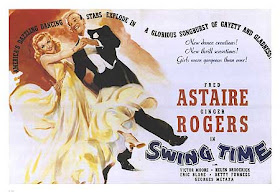Thursday, July 7, 2016
Short Take: Swing Time
The major difference between 1935's Top Hat, the greatest of the Fred Astaire and Ginger Rogers vehicles, and the following year's Swing Time, is that while Top Hat seeks to delight, Swing Time's goal seems mainly to impress. The picture has no magic. Only "Pick Yourself Up," the first of the stars' three dances, has a sense of joy from start to finish. "Waltz in Swing Time" and "Never Gonna Dance," the couple's other two numbers, start beautifully. But then the choreography seems more concerned with razzle-dazzle than expression. By the end of the dances, one is certainly astonished by the skill and (especially) the speed with which Astaire and Rogers perform the complex routines, but there's no emotional sweep to carry one along. It's empty virtuosity. Astaire's showpiece solo number, "Bojangles in Harlem," is also more impressive than likable, although for different reasons. There are two sections. The first has Astaire performing with two dozen chorus girls, and the second has him dancing with three oversize cast shadows of himself. On a technical level, it may be the most spectacular tap-dance sequence ever filmed. Unfortunately, Astaire performs it in blackface. While the racism is more insensitive than patronizing, and it's not at all hate-driven, it still doesn't sit well. The film has other major weaknesses. The first is that the screenplay, credited to Howard Lindsay and Allan Scott, doesn't have the snap of well crafted romantic comedy. The scenes never seem to be going anywhere. A bigger problem is the overly stately direction by George Stevens. His staging and shot compositions are too studied, and he gives the film's story sections a leaden pace. It feels like an eternity between dance numbers. Even Van Nest Polglase's Art Deco sets seem drained of panache. The cast also includes Victor Moore and Helen Broderick, who play the stars' respective sidekicks. The songs are by Jerome Kern (music) and Dorothy Fields (lyrics). Fred Astaire choreographed the numbers with Hermes Pan.
Reviews of other Astaire & Rogers films:

No comments:
Post a Comment